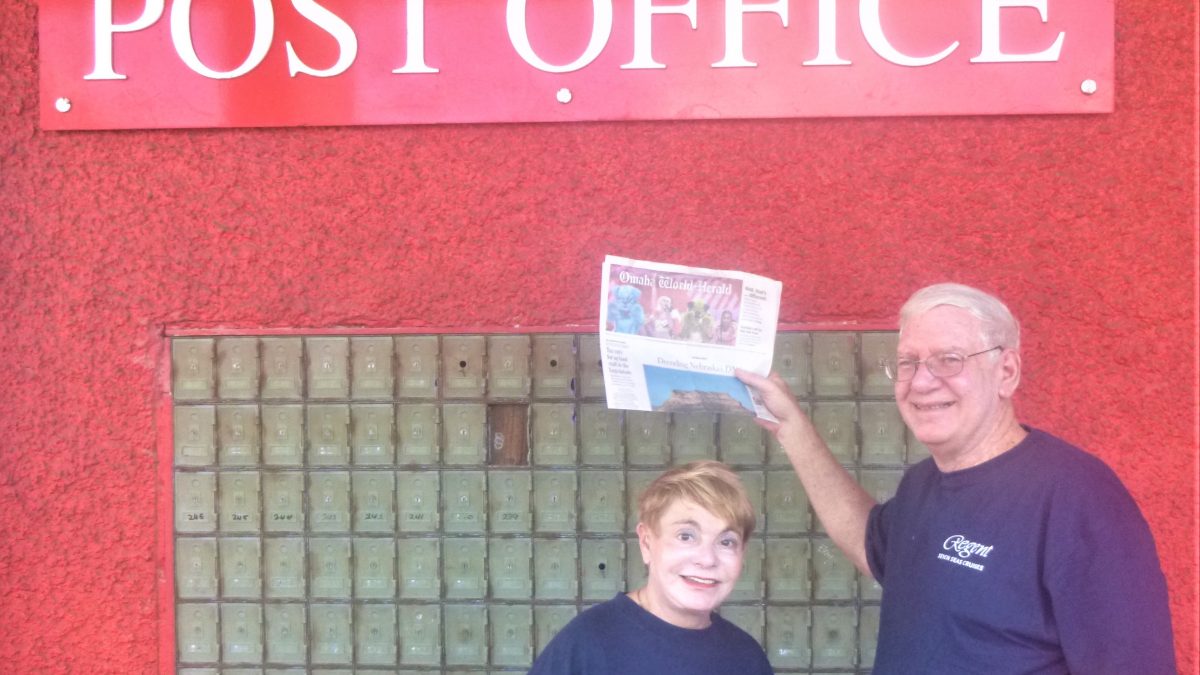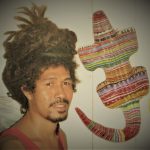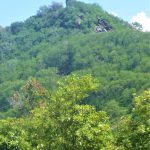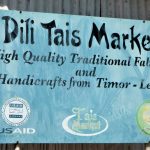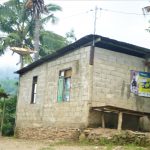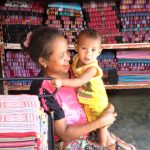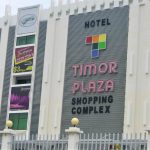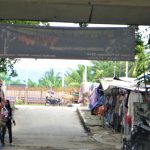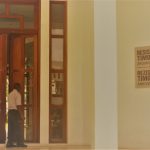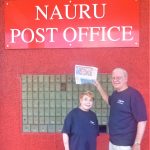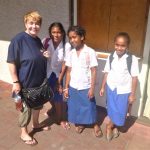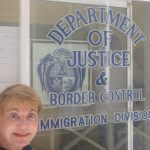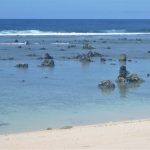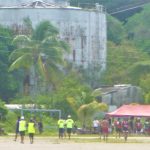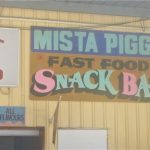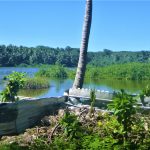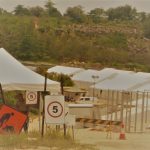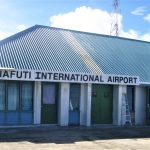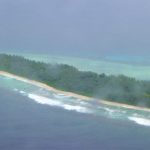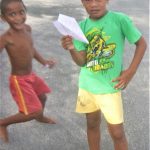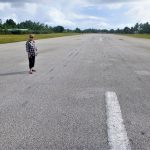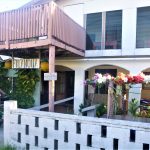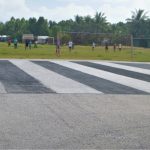East Timor, Nauru and Tuvalu (2014)

Moldova and Transnistria Memoir (2014)
January 1, 2014
Congo (2018)
January 1, 2018Fran & Rich’s Journey to Hell and Back: East Timor, Nauru, and Tuvalu
The Beginning of the Journey
Our travel agent, Audrey, named this the trip to hell and back, mainly because she had great difficulty making both air and hotel reservations to these out-of-the-way places. You can read below to see whether our visit to these unusual islands of Oceania really fit Audrey’s description. It’s lengthy, but I hope you find it interesting.
An ominous beginning: a long delay leaving LA. First, one man had a minor heart attack, and was helped off the plane. Then, while taxiing out to the tarmac, a lady had two epileptic seizures. We returned to the gate, paramedics came on and helped her and her companion disembark. Then another passenger got nervous about the chain of events and wanted off. We had never been on a plane before with two separate medical emergencies. Neither had the flight attendants. We took off two hours late, but made our connections in Auckland, New Zealand, and in Brisbane, Australia. We finally arrived in Darwin, Northern Territories, Australia, 40 hours and 15 1/2 time zones after leaving Omaha (just to throw us off a little more, Darwin’s time is a half hour earlier than Brisbane’s).
Darwin, at the northern tip, or “top end” as they say, is a very different city from the rest of Australia. It has a tropical climate, very wet from October thru March, very dry the other months, and hot year round. We had seen most of its sights on previous visits: jumping crocodiles, a WWII museum showing the Japanese air attack on the town, and Kakadu National Park with its unusual flora, fauna, desert landscape, and “Crocodile Dundee” characters. So this time we went to the Northern Territories Museum where we saw a wonderful collection of arts and crafts produced by the area aborigines. There was also a scary display of the total devastation wrought on Darwin in 1974 by Cyclone Tracy, and how the city has been rebuilt bigger and storm-resistant.
Of course, traveling with Fran always involves planning of meals. So our first dinner was at the Crustacean Restaurant. We ate at a seaside table at the far end of a wharf extending into Darwin Harbour. I thoroughly enjoyed my very favorite dish: mud crab. Don’t worry, they take all the mud off first. I had eaten mud crab before in Sydney and Melbourne, but this big fella prepared with a spicy Singaporean sauce was the best I’ve ever had. Mmm… We also enjoyed other culinary delights in Australia including soft shell crab tempura, grilled octopus, Morten’s Bay bugs (small langostinos), and fresh grilled barramundi fish.
We rose at 2:30 AM to catch our early flight on Air North Airline to Dili, East Timor . Air North was one of several little known airline companies that we flew on this journey. They included Jetstar (Qantas’ “no frills” branch), Fiji Air to and from Tuvalu, and, our personal favorite name, Our Airline, to Nauru and back. Fiji Air is the new name of Air Pacific. Why was it renamed? Because Air Pacific had the absolute lowest customer satisfaction rating of any of the dozens of Eastern Hemisphere Airlines. In fact, they had lost our luggage on a previous trip to Tonga, but that’s another story…
East Timor: From Hell to a Pleasant Nation
The 80 minute flight northwest from Darwin to East Timor was fine. We collected our luggage, paid US $30 each for entry visas, and saw a man holding a sign with our name. He took us to the Discovery Inn in Dili (isn’t that a great name for a capital city!). Included in the rate was transfer to and from the airport, in-room WiFi (which did work about half the time), air conditioning (which actually cooled the bed that the louvers faced), a bathroom with a shower and plenty of hot water, a helpful staff, and, most important for Fran, an excellent restaurant.
We arranged to have an English speaking taxi driver who would hopefully act as a guide. But at 10 AM we learned that the driver, Faustino, was already engaged, so our guide was now Lionel. Although he spoke a few words of English, Lionel was not a guide. Occasionally he would call out the name of a building we passed, but he couldn’t explain it’s significance. Luckily, we had done our “homework”, and gave him a list of places around Dili that we wanted to visit. The highlight was to be the Museum of Timor Leste (East Timor in Portuguese) Resistance. It was closed, only for the day, we hoped.
So we went to Comarca, which is the “museum” where Timorese independence fighters were taken for interrogation and torture. We were told at the gate that it was still operating as a prison. Although we could have visited a current inmate, we couldn’t see the old prison until late that afternoon. We didn’t go back.
Next on the list was a drive along the coast. After awhile we spotted Cristo Rei, a very large statue of Christ perched atop a high hill overlooking the bay. It reminded us of Christ the Redeemer, the huge sculpture that is the famous landmark of Rio de Janeiro, Brazil. We were going to climb the wide concrete steps to the top, but it was still the rainy season in East Timor, and the mud covering much of the walkway quickly dissuaded us of that notion.
Instead we asked to be taken to the Tais Market where we found stall after stall filled with the national dress. Tais (pronounced Tay-iss) are long colorful cotton skirts with thin horizontal stripes. Although Fran didn’t buy one, we did purchase a baseball cap and a T-shirt, each in the black, red and yellow colors of the Timorese national flag. For some odd reason, the hat was only two bucks but the T-shirt was $10; and they were both probably made in either Indonesia or China.
The U.S. dollar is the official currency of East Timor, but they have their own coins with values of one to 100 cents. That’s good news for all kids who collect foreign coins, except for my friend Mike’s daughter Olivia, who only collects other countries’ paper currency (well, she is a banker’s daughter).
Next we headed for the Alola Foundation, a shop where handmade Tais and other products are made by local women, and the profits shared by them. Fran likes to support these projects and found a nice cloth pocketbook to buy. When we headed over to Timor Plaza, the only large modern mall in the country, there was also an Alola Foundation store, but the prices were higher than in the original, typical shop (to pay the high rent, I suppose).
Our last stop for the day was at the main Post Office. I was delighted to find what I collect: first day covers. They are new stamps, placed on commemorative envelopes the first day they are issued, then postmarked with that date. The best was the stamp issued for East Timor’s first day of independence in 2002. Of course, the stamp has the nation’s flag on it.
The next day Faustino did pick us up, but his English wasn’t any better than Lionel’s. We went immediately to the Archives and Museum of East Timor Resistance. Its a fairly large building that has video, audio, and written descriptions, in three languages including English, of the long struggle for nationhood. The Portuguese colonized East Timor in the sixteenth century, then the Dutch took over West Timor and the rest of Indonesia. So in East Timor the native population became Roman Catholic, and Portuguese became the official language, while in West Timor the locals were Muslim and spoke Bahasa Indonesian or Dutch.
In World War II the Japanese conquered the whole area. After the war, Indonesia achieved independence. East Timor was about to gain the same status in 1975 when Indonesian troops invaded. 25 years of hell followed: peaceful protests disbursed by soldiers firing rifles, resistors armed only with machetes decimated by the Indonesian Air Force and Army, the general population starving. The number of people in East Timor went from 640,000 to 480,000, that is about one-fourth of the population were killed, died, or fled! Sadly, it was a little-known genocide.
In 1989 a large group of unarmed protestors gathered by the Santa Cruz cemetery in Dili. Indonesian soldiers began firing in what they described as a “minor incident”. One person secretly filmed the grisly scene and managed to smuggle it to Australia. The evidence of the massacre of 200-300 innocent civilians was shown world-wide.
Until 1989 Australia had sided with Indonesia, both governments benefiting from a treaty sharing the oil and gas rights in the sea between Australia and Timor. The American government also had favored the Indonesians because some of the Timorese rebels were left-leaning, while Indonesia was led by the rightist strongman, General Suharto. But after the terrible film was shown, pressure mounted on Indonesia. A plebiscite was held, and 93% of the East Timorese voted to set up their own nation. In 2002, the Republic of Timor Leste (East Timor) was created. It is a functioning democracy whose Prime Minister was one of the revolutionary leaders.
The people of East Timor are very poor, but things are slowly getting better. There are many governmental (US AID, Australia AID, United Nations) and non-governmental (CARE, church-based, etc.) agencies helping improve education, health, infrastructure, and the like. Education is compulsory now. Doctors are coming from Cuba. Petroleum is drilled offshore and the government’s share of the royalties are deposited in a trust fund in New York City. According to a CARE official we met, the finances of the government are transparent, even the billions in the trust fund.
But there plenty of problems: East Timor is rated very low as a place to invest and do business. The Portuguese invested little in education, and during the struggle with Indonesia there was even less. So there are good jobs available, but adults lack the education to fill them. Another problem is the birth rate. Like most underdeveloped countries, traditional practices promoted large families. But here, even when people get a little money and education, having many children is still the norm. This may be due to the prevalence of the Roman Catholic faith, or just to a continuation of custom, but the fact is that most of the people we saw were under 20.
There is food to eat — fish, chicken, locally grown fruits and vegetables — but there is not much cash around. The only cash crop is coffee, much of which is sold to Starbucks. In Dili there are lots of motor bikes, and even many cars, but traffic is not yet a real problem for this city of 250,000. The total population of East Timor is about 1,000,000, and many of them are moving to Dili where there are more jobs available, even if the living conditions are not good. Most of the young people speak some English along with the local Tetum language.
We took a drive up the curving mountain road looking for the World War II memorial. The narrow road was rutted and the pavement broken, but we had a good chance to see how people lived in the rain forest above the city. As in Dili, most houses are basically shacks, but most did have electricity. And, as in Dili, most students were dressed in uniforms. We did get to the war memorial, a series of banners dedicated to the memory of the Australians and Timorese who fought the Japanese. Portugal was officially neutral during WW II, so those brave men had to fight on their own.
Our final “tour stop” was to Arte Moris, a large art school and gallery in Dili. There were some large sculptures on the outside grounds, but most works were displayed in a large two-story domed structure with roof leaks, flaking whitewash, and tile that broke as I stepped on it. We found a paper mâché creation in the shape of a crocodile. It was beautifully painted with thin colorful horizontal lines to look like a tais. We went outside the dome to the little office, negotiated the price, and bought it. The tail broke off on the way home.
The next day we flew back to Australia, thoroughly satisfied with our brief but very interesting stay in East Timor. Although the country was a hell from 1975-2001, it is making progress to become a decent place to live for its citizens.
Nauru: From the Pleasant Island to Hell
After a 24 hour stay in Brisbane, Australia, we went with trepidation to the airport to find the Our Airline flight to Nauru. At the Brisbane airport we met Jim, an American from Colorado. Like us, Jim was trying to visit every recognized nation, which is why he was heading for Nauru after seeing Tuvalu. He said he only had about 20 (out of 185 or so) to go. Jim told us about his unique twist to every country he toured: “My wife passed away 5 years ago. She loved traveling too. She asked me to scatter her ashes wherever I go, so I’m doing as she requested.” He said he was traveling the world with Ashley, but I think that name was just a poignant pun.
Nauru, called “the Pleasant Island” 100-200 years ago, is located about halfway between Australia and Hawaii. It is the smallest republic in the world, only 8 square miles and only 10,000 people. (Vatican City and Monaco are smaller in area, but they are not republics.) It’s also the one least visited by tourists, only 200 a year! So although we and Jim were the only tourists on the plane, the 3 of us made up almost a weeks worth of tourists. We were about to find out why.
Just finding out how to get to Nauru had been a lengthy search. Even when we learned that the national carrier of Nauru was called Our Airline, it was hard to contact them, harder to figure out the schedule, and hardest to actually make a reservation. Clutching our E-tickets and passports firmly in our hands, we strode up to the Our Airline check-in counter. But the Russian-Australian young woman check-in clerk emphatically told us: “You cannot board as you have neither a Nauru visa nor a confirmed hotel voucher. ”
We explained that we could buy a visa when we landed, and showed her a printout of the E-mail from the Menen Hotel stating they had reserved a room for us. The lady officiously declared , demonstrating her Russian heritage, “An E-mail is not a confirmed reservation at a hotel. You can’t board.” Calmly, without showing our inner stress, we requested, “Please ask the manager”. She strode over to her supervisor, conferred for what seemed like an eternity, came back, wrote “No Confirmation” on the ticket, but let us go to the boarding gate. After all that, flying the 4 1/2 hours on Our Airline’s old 737 was not really bad. We landed at the small Nauru International Airport on time, but we were tired after the overnight flight.
We paid $50 for our Nauru visa, collected our luggage, and went outside to look for the Hotel Menen van. It was nowhere to be seen. A local person called the hotel for us, but there was no answer. Finally an old battered taxi mini-van appeared, so we shared it with Jim. At the hotel, the young desk clerk greeted us but didn’t apologize for missing our pickup. Generally, the people in Nauru are not unfriendly, but neither are they warm and welcoming. Perhaps that is from their Micronesian (rather than Polynesian) heritage.
After the nasty things said by previous guests about Hotel Menen on Trip Advisor, the Internet tourism website, we were prepared for the worst. Actually, it wasn’t terrible, but we rated it 2 stars (out of 5). Here’s the good and the bad: our room was towards the end of the long strip of two story buildings, so we had to walk through the offensive odor coming from the septic tank; the air conditioning was a basic box, but worked OK if we kept it operating 24 hours; the bathroom fixtures were fine, but there was never any hot water; there were a few ants and other insects but no vermin; there was no water in the pool; there was a nice ocean view, but our window was broken and taped up; you couldn’t swim or even walk on the beach because it was covered with tall, sharp, black coral rocks; there was no WiFi but there were two computers in the lobby with slow connections that you could use for $5/ hour; the restaurant was fair at best, and breakfast was extra. There was nothing but the room included, and that was minimal at best. Yet we felt the $95/night rate we had been quoted was reasonable, especially considering the hotel was usually sold out with Australian workers.
When Nauru became independent in the 1968, it may have had the highest per capita income in the world! Huge, almost pure, phosphate deposits had been discovered earlier, and the island had huge industries mining and exporting it as fertilizer. Whether the phosphate was caused by : 1) natural formation, 2) ancient coral containing organic marine life being pushed up volcanically in the middle of the island, or 3) the result of thousands of years of bird excrement (guano), has not been definitively answered. Personally, I like the birdshit theory.
It was during those boom times that the Menen was built as a luxury hotel. Unfortunately, at the same time that the phosphate deposits were being used up, agricultural companies developed synthetic fertilizers that dropped the price of phosphate. Today there is still phosphate mining in Nauru, but its nothing like what it was. Money and jobs were lost, and now Nauru reportedly has a 90% unemployment rate. Nauru doesn’t even have a capital. The Parliament building is in one district, some government offices in another, and the inhabitants live spread out alongside the coast.
Meantime, the Menen Hotel also fell on bad times. Anything that broke was not repaired, and remodeling and renovation of rooms and facilities was unknown. So the place is over 40 years old and in a deteriorated, crumbling condition. Now that Australia has set up refugee camps on Nauru, and the camp staff need a place to stay, it’s become hard to get a reservation. But the Australian Government is fed up with paying up to $300/night for their officials, so new facilities are being built. Pretty soon it will be easy again to get a room at Nauru’s “Grand Hotel”. Maybe they’ll even start fixing things?
What’s to do? In the smallest island nation in the world, one can circle the island by car in a 30 minutes, bike it or even run around it in a few hours. You don’t have to worry about getting lost as the only paved road goes along the coastal shore. We did hire a taxi to circumnavigate the island. We stopped at the post office, and they did have some nice first day covers to buy. They also had prepaid picture post cards for only $1. We seldom send postcards anymore, except to our kids and grand kids, as E-mail is so much faster, cheaper, and more efficient. But Nauru was such an unusual destination, and $1 was such a low price, that I did buy 20 to send. Jim bought 40.
Our next stop was at Capelle’s, the only large store on Nauru. It had everything from food to household goods to refrigerators to boats. Fran always carries some nuts in case of food “emergencies” as they are a good source of protein and other healthy stuff (don’t ask me what). So we bought some packaged nuts and a polo shirt that says “Nauru”. It doesn’t say “the pleasant isle”.
We did drive inland to see the Buada Lagoon. It’s a small lake surrounded by very green foliage. It could be a really beautiful tropical setting were it not for the low metal fences, trash and debris that transform the scenic lagoon into a five minute stop (and that’s for two photos on different sides of the water).
The next day Jim said, “Let’s see the other half of Nauru”.
I said, “But we already drove around it”.
His reply: “Today we’ll drive counterclockwise instead of clockwise”.
I couldn’t argue with that logic, but I requested that we try to see the refugee camps. We got a taxi whose driver was a young woman, Eva, who had only driven once across the high plateau that covers much of the island. Called the Topside, the desolate area consists of low hills covered with sparse vegetation dotted with empty plastic bottles, phosphate pits, rusting mining machines, and garbage dumps. No locals live there. The rutted gravel road was uncomfortable for us and hard on the old car, but Eva pressed on. There were several narrow roads criss-crossing the Topside, and we and Eva soon realized we were lost. It’s such a small island that we thought being lost was more funny than a reason for concern, except that the gas gauge was close to “Empty”.
We came to a “T” in the road. The arrow on the sign that said “Camp 2” pointed to the left, and we could see a couple of buildings there, so naturally Jim and I asked Eva to go to the right, toward Camp 3. She complied, over Fran’s protests. Fran, of course, was right. It took us another 25 minutes of wrong turns, dead ends, and U-turns before we finally spotted a big gate with fences and armed guards. We could see several large prefab white buildings inside the camp. We drove up, stopped, and one of the guards walked over and asked, in a broad Australian accent, “Can I help you?”.
Jim replied, “We came for lunch in the restaurant.”
The guard didn’t seem amused. “Do you have a written pass or other document?”
“No, but can we just drive in and look around?”
“Sorry, mate, you can’t.”
“Can we take pictures from the car?”
“No, mate.”
With that, we backed up 20 feet, I took some pictures anyway, and we drove away.
The refugee camps were set up in 2001 when boatloads of desperate people from East Africa, the Middle East, and South Asia tried to sail to Australia to start a new life. Many died when their overcrowded ships foundered and sunk. Australia had signed a UN pact agreeing to take refugees from other countries who were seeking asylum based on political or religious persecution. However, there is no acceptance of those merely seeking a good job or a better life. The Australian Government doesn’t welcome everyone who shows up on its shores. So Australia now has camps in the isolated islands of Nauru and Papua New Guinea to house the refugees while they were being investigated as to whether they should be admitted or not.
Most of the refugees don’t have passports, money, or anything else. Processing the information is a long and difficult, if not an impossible task. The refugees in Nauru are put in either a family camp (if they arrived as a family) or single sex camps. There are well over 1000 people just in the Nauru camps. They live in basic tents. Meals, some English instruction, and social skills are provided by Australian workers, but its a hot, boring, prison-like life for those unfortunate souls.
We spoke with several Australians who work at the camps. They rotate in and out for two weeks up to three months. The consensus was that it was a good-paying job but with lousy working conditions. For example, we chatted with Babek, an Iranian-Australian who works as a Persian translator at the camps. He said the staff lives in the large prefab buildings. They are air conditioned but the workers have to live two to a small room so there’s no privacy nor amenities. “But,” Babek added, “it’s much worse for the refugees. They have nothing to do but wait in the heat for their application to be processed.” Some of the refugees have given up and want to return to their native country. However, without passports or other documents, they usually can’t go back. They have become people without a country.
The final irony is that even if a refugee is approved for immigration, he or she is just released to live in Nauru, where the unemployment rate is sky-high. The Australian government is spending millions of dollars every year to house, feed, and acclimate the refugees to Western customs, and to pay and accommodate Australian camp workers. Very few refugees are approved for immigration, or even to be returned to their home country. More refugees are always arriving by boat, as the people of Iran, Iraq, Somalia, etc., are still told by nefarious people-smugglers that they will be welcomed into Australia. It’s a terrible situation, and getting worse, with no solution in sight.
What about the local Nauruans? Quite a few are now employed as aides and construction workers at the camps. Others are manning restaurants, taxis, and inns to take care of the Australians’ needs. So I’m sure the unemployment rate is significantly down from 90%. Fishing and phosphate mining are still done. Home gardens grow fruits and vegetables. All the houses have electricity, and many have satellite dishes.
Nauruans are reportedly the fattest people in the world. (One of the reasons we wanted to go to Nauru was to feel like we’re thin…and we did!) They are of Micronesian stock, who are generally heavier even than Polynesians. Side note: Air Samoa in Polynesia is the first airline to charge passengers based on their weight! The Nauruans’ diet is primarily rice and potatoes. We did see a group of young men playing touch rugby, but no other physical activity. Between motor scooters and the public bus that circles the island hourly, not many locals do much walking. So, yes, the adults are very obese, especially the women. Consequently, Nauru has the highest level of type 2 diabetes of any country.
Nauru had a trust fund of over one billion dollars, built up during the big mining days, plus payments from other nations for fishing rights. Unfortunately, bad investments made by the trust fund managers have reduced it to almost nothing. Corruption undoubtedly played a part too. Today the government of Nauru receives a lot of money from Australia for the land for the camps, but overall it’s a very poor country. Sad to say, but expansion of the refugee camps is probably the best thing that can happen to Nauru.
A final unpleasantness: checking out of Hotel Menen the clerk asked us for $270 Australian. We knew that credit cards are not taken, and that only Australian currency is taken, and that the U.S. and Australian dollars are about equal in value (at that time). But our rate was quoted at $95/ night, for two nights equals $190. I showed the clerk the printed e-mail. She said, “I’m sorry, $270 is correct.”
“Can I see the manager?
“I’m sorry, the manager is off on Sunday.”
“Can you phone him?”
Eventually the manager did come in. He showed me the official rate card which indicated $135/night = $270 for our room. I proffered our printed e-mail again. He said, “I’m sorry, Jeaneta {the owner} must have made a mistake.”
“Can you call her?”
“I’m sorry, I can’t reach her. But please note that we gave you an upgraded room that had more space, 2 beds, and an ocean view.”
” Thank you, but I’m just going by the quoted rate.”
This exchange was repeated a couple of times. Finally I took out the $220
Australian I had in my wallet, and said in essence, “Final offer. Take it or leave it.” He took it, we shook hands, and parted amicably. We left Nauru, pleased to have seen the least-visited nation in the world, but now understanding why it is so.
Tuvalu: the Way Back
Our next destination was Tuvalu, located not too far from Nauru in the Pacific Ocean, halfway between Australia and Hawaii. But we had to fly back on Our Airline to Brisbane first. We had a rejuvenating day in Brisbane, enjoying that beautiful city with its many museums and riverside seafood. Then we took an overnight flight to Nadi (pronounced Nandi), Fiji, pulled all our luggage over to the domestic terminal, boarded a prop plane for a 30 minute flight to Suva on the other side of Fiji, followed by a 2 1/2 hour flight north to Tuvalu. Whew!
Tuvalu is the second smallest republic in the world, being slightly larger than Nauru and having 11,000 people (1,000 more than Nauru), most of whom live in the capital, Funafuti. I love the name Funafuti, don’t you? Just sounds like a nice little place…and it is.
The nation consists of several small coral atolls in the middle of the Pacific Ocean, just south of the Equator. It was part of the British Empire until it gained its independence in 1978. The United States gave up its territorial claims to several islets that became part of the new nation. Expansionist America had claimed them in 1856 in the Guano Islands Act. (I have a preference to any real references to bird crap.)
Tuvalu is still part of the British Commonwealth. In fact, we talked with Commonwealth advisers from Samoa, Tonga, and Trinidad who were in town for a leadership conference. Tuvalu does receive aid and assistance from Australia, the U.S., and especially from New Zealand. It also earns income from the sale of postage stamps and fishing licenses, plus $10 million annually from the South Pacific Tuna Treaty. Another couple of million a year comes from modern technology: the sale of the “TV” Internet domain name.
Unfortunately, the highest spot on any island is only 15 feet above sea level. If global warming continues and the seas rise, Tuvalu may well disappear below the ocean waves.
What should depress the people of Tuvalu more is that the coral sand contains no nutrients for growing crops. There are some coconut and fruit trees, and green foliage, but most food has to be imported on the monthly cargo ship. Almost the only jobs are working for the government. Hundreds of people take seasonal jobs in New Zealand like harvesting wine grapes and agricultural products. Some work full-time in other countries and send money home. As Polynesians, they are natural seafarers, so many work as seamen on merchant ships.
Yet the people are friendly and happy. They seem to enjoy zipping around Funafuti on their motor scooters and just being with each other. It’s the only place we’ve ever been where we never rode a motorized vehicle, but the locals usually did. Getting off the small aircraft, we went through customs and immigration, got our wheeled bags and pulled them 50 yards across the airstrip to the Filamona Lodge.
Our room wasn’t even as nice as the one at the Menen. The windows were curtained as, when opened, there was just a shack and junk pile across the narrow alley. The key stuck in the lock if you could open it. The tiny sink in the corner had only cold water. The shower consisted of a thin pipe coming out of the wall with a rusted handle. It took over 30 hours to cool down the room to a tolerable temperature, which made the cold shower a refreshing experience. Yet the welcoming and friendly atmosphere of the staff and the other guests made us happy to be there.
Things to see and do? Not much. We walked past the Parliament to the Post Office. The clerk there apologized and said that first day covers and other stamps were now sold at the Philatelic Center down the road. So we walked ten minutes in the heat to a small structure filled with shelves piled with dusty plastic envelopes containing thousands of old first day covers for the low price of $2 each. Tuvalu used to make lots of money selling stamps worldwide, but with the rise of the Internet, stamp collecting has lost most of its appeal. We purchased several interesting ones (commemoratives of Elvis, Abraham Lincoln, etc.) that were in good condition. We also bought a few prepaid picture postcards to mail to our kids. It’s always interesting to see how many months it takes for cards to be delivered from overseas. The stamp clerks were so thankful for our purchases that they gave us a bunch of uncancelled single stamps with unusual shapes and subjects.
We had met a Chinese man in the airport who was also trying to visit every country. He would take home to Shanghai stamps and coins from wherever he went. He bought about $100 worth of assorted stamps, so the philatelic office had a good day.
Although Tuvalu transactions are made in Australian dollars, and no one can use credit cards or ATM’s, it has some of its own coins. The fifty-cent piece has a stylized octopus on one side and, due to its Commonwealth standing, Queen Elizabeth II on the other. The $1 coin has a turtle on the back side of the Queen (sorry, couldn’t resist phrasing it that way). We brought that one back for Olivia, the banker’s daughter, to see if she’ll make an exception to her paper-money-only collection.
Later we walked in the other direction and found the 3 T’s Chinese restaurant. Just like there are Chinese restaurants all over the USA, they are even found in even the most isolated places. Both the stir-fry pork and the chicken fried rice dishes were tasty, even if with little meat. Fran usually buys bottled water to drink at remote places where neither the water nor ice is safe, then adds a powdered or liquid flavoring. I usually just buy a local beer, but her flavored water drinks are actually quite nice, even if they take up half a small suitcase at the start of a trip.
The next day we strolled down the airstrip, dodging the little boys who were avidly, and appropriately, flying paper airplanes. In the grass, just beyond the end of the tarmac, young men were playing soccer (no rugby here that we saw). On the north side of the airstrip was a large fenced garden. It had been set up by the Republic of China (Taiwan) as a model garden to grow vegetables. Hundreds of potted tomatoes, peppers, onions, Chinese cabbage, eggplant, cucumbers, and other veggies seemed to be doing well. Whether those plants can thrive in Tuvalu’s poor soil is unproven.
Fran walked over to the little building housing the National Library and Archives. The librarians were pleased to see an overseas visitor, and thrilled when she gave them a couple of paperback books she had finished.
At noon the next day two little fire engines rolled out of their shed with sirens blaring. They were not for a fire. Rather, they were to get everyone off the airstrip as the twice-weekly plane was due in. It was also a signal for us to roll our suitcases the 50 yards back to the tiny terminal building. They hand-wrote our ticket and hand searched our carry-on’s. We paid the $30 each exit fee, walked out to the plane, boarded, and flew out.
Conclusion
Was it a trip to hell and back? East Timor was a hell 25 years ago; the refugee camps on Nauru today are certainly hellish; and Tuvalu, well, it was like a trip back in time. All in all, a very different and memorable journey.
Sent from my iPad=

